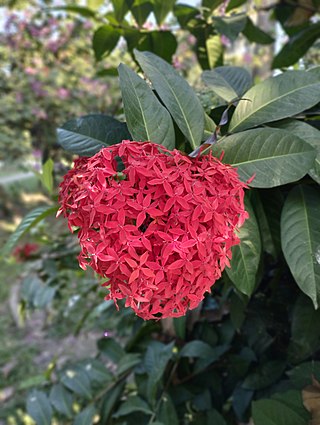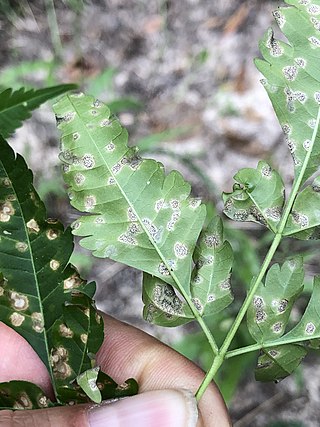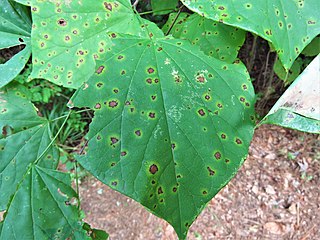Blight refers to a specific symptom affecting plants in response to infection by a pathogenic organism.

Hevea brasiliensis, the Pará rubber tree, sharinga tree, seringueira, or most commonly, rubber tree or rubber plant, is a flowering plant belonging to the spurge family Euphorbiaceae originally native to the Amazon basin, but is now pantropical in distribution due to introductions. It is the most economically important member of the genus Hevea because the milky latex extracted from the tree is the primary source of natural rubber.

Malus sieversii is a wild apple native to the mountains of Central Asia in southern Kazakhstan. It has recently been shown to be the primary ancestor of most cultivars of the domesticated apple. It was first described as Pyrus sieversii due to its similarities with pears in 1833 by Carl Friedrich von Ledebour, a German naturalist who saw them growing in the Altai Mountains.

Ixora is a genus of flowering plants in the family Rubiaceae. It is the only genus in the tribe Ixoreae. It consists of tropical evergreen trees and shrubs and holds around 544 species. Though native to the tropical and subtropical areas throughout the world, its centre of diversity is in Tropical Asia. Ixora also grows commonly in subtropical climates in the United States, such as Florida where it is commonly known as West Indian jasmine.
Pseudocercospora cannabina is a fungal plant pathogen infecting hemp. Cercospora cannabina was originally found on the leaves of Cannabis sativa in Uganda. Then in 1976, it was renamed as Pseudocercospora cannabina by mycologist Frederick Claude Deighton (1903-1992).
Pseudocercospora fuligena is a fungal plant pathogen infecting tomatoes. It is the cause of the fungal disease black leaf mold. The fungus was first described in the Philippines in 1938 and has since been reported in numerous countries throughout the tropics and subtropics. It was reported in the United States in 1974, initially in Florida, and has since been reported in non-tropical regions including Ohio and North Carolina.
Pseudocercospora puderi is a fungal plant pathogen infecting roses, including Rosa gallica. It was originally found in Florida, USA.
Pseudocercospora rhapisicola is a fungal plant pathogen infecting palms.

Pseudocercospora subsessilis is a fungal plant pathogen infecting chinaberry tree. It is widespread in tropical and subtropical areas on host species of the genera Azadirachta and Swietenia.
Pseudocercospora theae is a fungal plant pathogen infecting tea. It was originally found on the fallen leaves of Thea viridis in Italy.

Pseudocercospora vitis is a fungal plant pathogen which causes isariopsis leaf spot,.
Gibberella baccata is a fungal plant pathogen. It is a common finding worldwide. It is common in soil and in woody plants, especially in tree tissues.
Pseudocercospora kaki is a fungal plant pathogen, who causes leaf spot of persimmon. It was originally found on leaves of Diospyros kaki in Taiwan. Some examples of other host species are Diospyros hispida, Diospyros lotus, Diospyros texana, and Diospyros tupru.

Malus sieboldii, commonly called Siebold's crab, Siebold's crabapple or Toringo crabapple, is a species of crabapple in the family Rosaceae.

Malus trilobata, the Lebanese wild apple, erect crab apple or three-lobed apple tree, is a species in the family Rosaceae in the genus Malus. Some authorities place it in the segregate genus Eriolobus, as E. trilobatus.

Pseudocercospora is a genus of ascomycete fungi. An anamorphic version of the genus Mycosphaerella, Pseudocercospora species are plant pathogens, including the causal agent of the so-called South American leaf blight of the rubber tree. The widely distributed genus is concentrated predominantly in tropical regions. Pseudocercospora was circumscribed by Italian-Argentinian botanist Carlos Luigi Spegazzini in 1910.

Entoleuca mammata is a species of fungus in the genus Entoleuca. It is responsible for the plant disease hypoxylon canker in hardwood trees such as quaking aspen and other aspens and poplars, Salix myrsinifolia and other willow species, rowan, Sitka alder, birch, apple, oak, and hop-hornbeam.
Pseudocercospora arecacearum is a fungus. It was originally found on the fronds of Rhopalostylis sapida in northern New Zealand, and it was published in 2006, along with other Pseudocercospora species; Pseudocercospora gunnerae and Pseudocercospora pandoreae.
Pseudocercospora gunnerae is a fungal plant pathogen. It was found originally on the leaves of Gunnera tinctoria in northern New Zealand.
Pseudocercospora pandoreae is a fungus.








